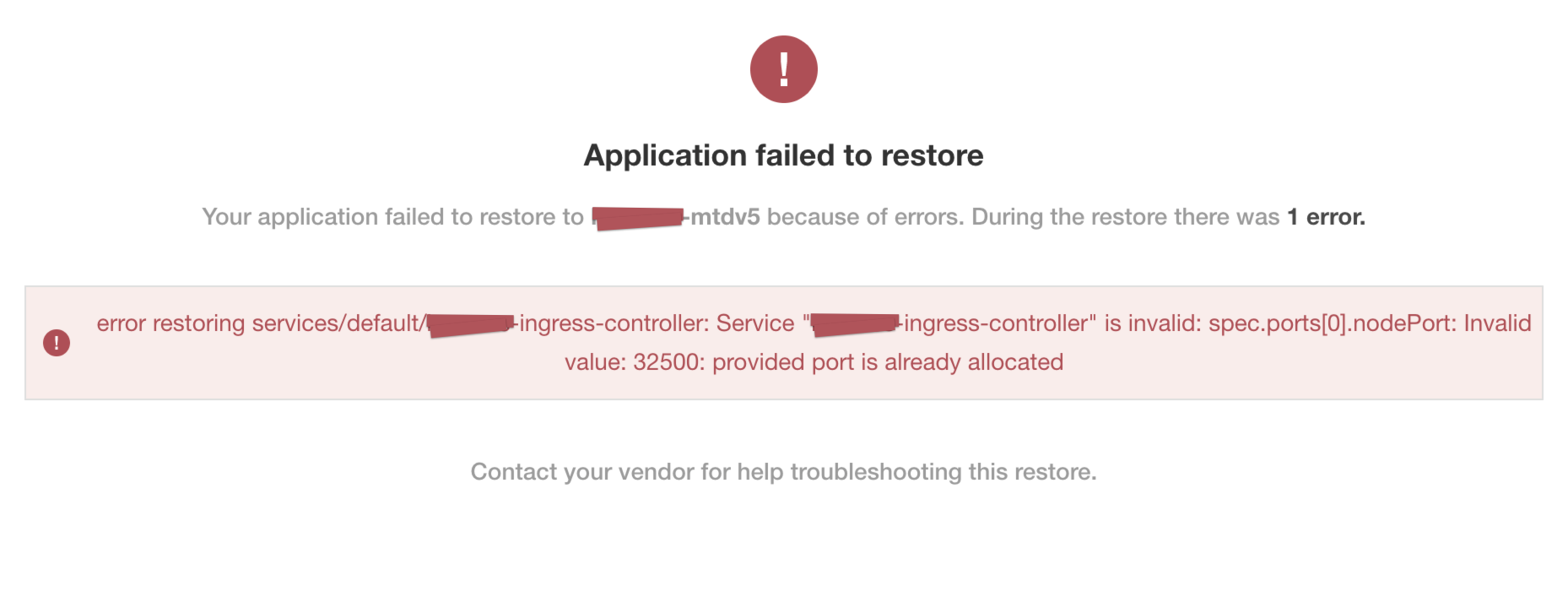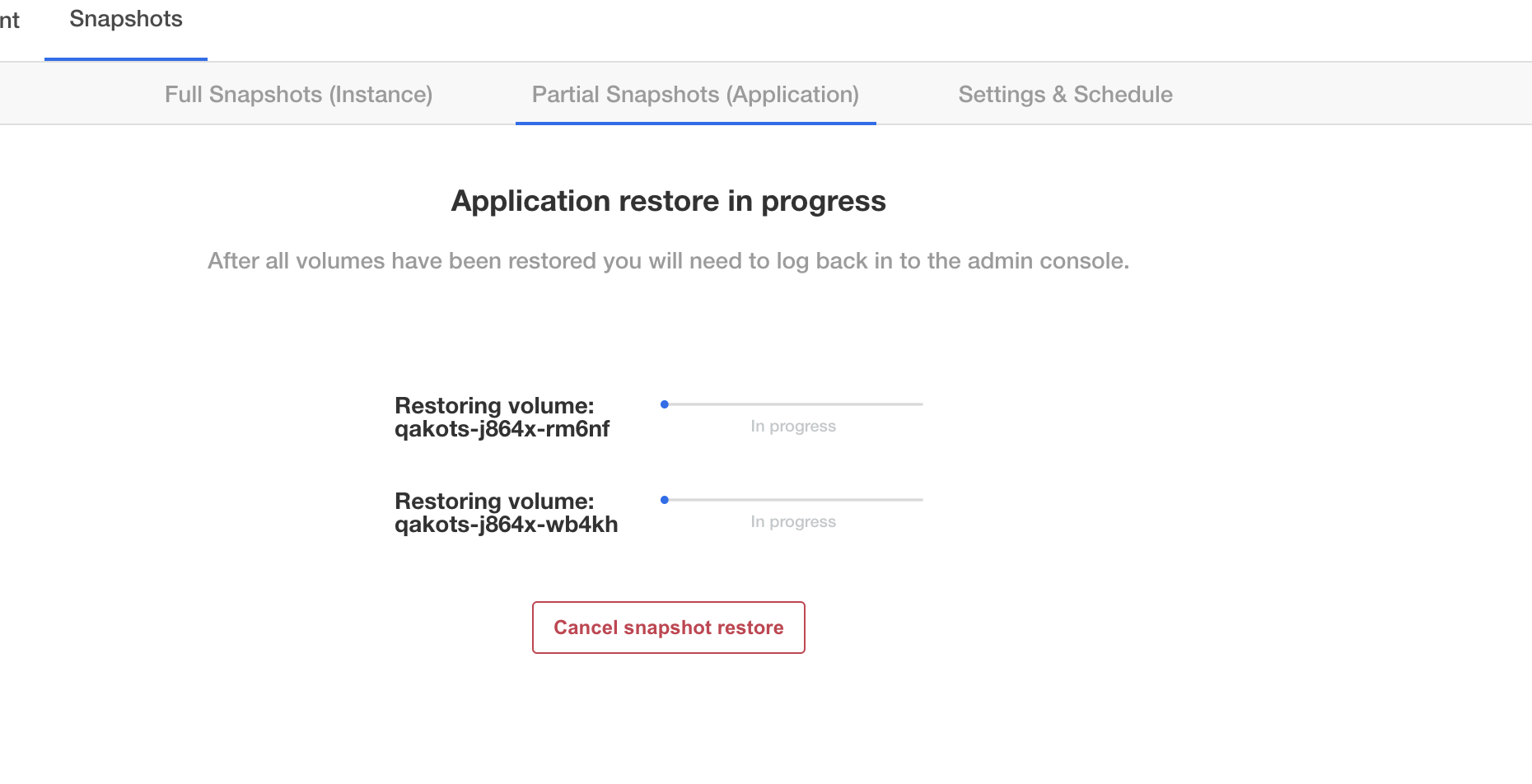Troubleshooting Backup and Restore
When a snapshot fails, a support bundle will be collected and stored automatically. Because this is a point-in-time collection of all logs and system state at the time of the failed snapshot, this is a good place to view the logs.
Velero is Crashing
If Velero is crashing and not starting, some common causes are:
Invalid Cloud Credentials
Symptom
You see the following error message from Velero when trying to configure a snapshot.
time="2020-04-10T14:22:24Z" level=info msg="Checking existence of namespace" logSource="pkg/cmd/server/server.go:337" namespace=velero
time="2020-04-10T14:22:24Z" level=info msg="Namespace exists" logSource="pkg/cmd/server/server.go:343" namespace=velero
time="2020-04-10T14:22:27Z" level=info msg="Checking existence of Velero custom resource definitions" logSource="pkg/cmd/server/server.go:372"
time="2020-04-10T14:22:31Z" level=info msg="All Velero custom resource definitions exist" logSource="pkg/cmd/server/server.go:406"
time="2020-04-10T14:22:31Z" level=info msg="Checking that all backup storage locations are valid" logSource="pkg/cmd/server/server.go:413"
An error occurred: some backup storage locations are invalid: backup store for location "default" is invalid: rpc error: code = Unknown desc = NoSuchBucket: The specified bucket does not exist
status code: 404, request id: BEFAE2B9B05A2DCF, host id: YdlejsorQrn667ziO6Xr6gzwKJJ3jpZzZBMwwMIMpWj18Phfii6Za+dQ4AgfzRcxavQXYcgxRJI=
Cause
If the cloud access credentials are invalid or do not have access to the location in the configuration, Velero will crashloop. The Velero logs will be included in a support bundle, and the message will look like this.
Solution
If this is the case, Replicated recommends that you validate the access key / secret or service account json.
Invalid Top-level Directories
Symptom
You see the following error message when Velero is starting:
time="2020-04-10T14:12:42Z" level=info msg="Checking existence of namespace" logSource="pkg/cmd/server/server.go:337" namespace=velero
time="2020-04-10T14:12:42Z" level=info msg="Namespace exists" logSource="pkg/cmd/server/server.go:343" namespace=velero
time="2020-04-10T14:12:44Z" level=info msg="Checking existence of Velero custom resource definitions" logSource="pkg/cmd/server/server.go:372"
time="2020-04-10T14:12:44Z" level=info msg="All Velero custom resource definitions exist" logSource="pkg/cmd/server/server.go:406"
time="2020-04-10T14:12:44Z" level=info msg="Checking that all backup storage locations are valid" logSource="pkg/cmd/server/server.go:413"
An error occurred: some backup storage locations are invalid: backup store for location "default" is invalid: Backup store contains invalid top-level directories: [other-directory]
Cause
This error message is caused when Velero is attempting to start, and it is configured to use a reconfigured or re-used bucket.
When configuring Velero to use a bucket, the bucket cannot contain other data, or Velero will crash.
Solution
Configure Velero to use a bucket that does not contain other data.
Snapshot Restore is Failing
Service NodePort is Already Allocated
Symptom
Example error message:

Cause
There is a known issue in older Kubernetes versions (earlier than v1.19) where using a static NodePort for services can collide in multi-primary high availability setup when recreating the services. You can find more details about the issue here: https://github.com/kubernetes/kubernetes/issues/85894.
Solution
This issue has been fixed in Kubernetes version 1.19. You can find more details about the fix here: https://github.com/kubernetes/kubernetes/pull/89937.
Upgrading to Kubernetes version v1.19 or later should resolve the issue.
Partial Snapshot Restore is Stuck in Progress
Symptom
In the Replicated admin console, you see at least one volume restore progress bar frozen at 0%. Example admin console display:

You can confirm this is the same issue by running kubectl get pods -n <application namespace>, and you should see at least one pod stuck in initialization:
NAME READY STATUS RESTARTS AGE
example-mysql-0 0/1 Init:0/2 0 4m15s #<- the offending pod
example-nginx-77b878b4f-zwv2h 3/3 Running 0 4m15s
Cause
We've seen this issue with Velero version 1.5.4 and opened up this issue with the project to inspect the root cause: https://github.com/vmware-tanzu/velero/issues/3686. However we have not experienced this using Velero 1.6.0 or greater.
Solution
Upgrade Velero to 1.9.0. You can upgrade using the Replicated Kubernetes installer. Or, to follow the Velero upgrade instructions, see Upgrading to Velero 1.9 in the Velero documentation.
Snapshot Creation is Failing
Timeout Error when Creating a Snapshot
Symptom
You see a backup error that includes a timeout message when attempting to create a snapshot. For example:
Error backing up item
timed out after 12h0m0s
Cause
This error message appears when the node-agent (restic) Pod operation timeout limit is reached. In Velero v1.4.2 and later, the default timeout is 240 minutes.
Restic is an open-source backup tool. Velero integrates with Restic to provide a solution for backing up and restoring Kubernetes volumes. For more information about the Velero Restic integration, see File System Backup in the Velero documentation.
Solution
Use the kubectl Kubernetes command-line tool to patch the Velero deployment to increase the timeout:
Velero version 1.10 and later:
kubectl patch deployment velero -n velero --type json -p '[{"op":"add","path":"/spec/template/spec/containers/0/args/-","value":"--fs-backup-timeout=TIMEOUT_LIMIT"}]'
Velero versions less than 1.10:
kubectl patch deployment velero -n velero --type json -p '[{"op":"add","path":"/spec/template/spec/containers/0/args/-","value":"--restic-timeout=TIMEOUT_LIMIT"}]'
Replace TIMEOUT_LIMIT with a length of time for the node-agent (restic) Pod operation timeout in hours, minutes, and seconds. Use the format 0h0m0s. For example, 48h30m0s.
The timeout value reverts back to the default value if you rerun the velero install command.
Memory Limit Reached on the node-agent Pod
Symptom
The node-agent (restic) Pod is killed by the Linux kernel Out Of Memory (OOM) killer.
Cause
Velero sets default limits for the velero Pod and the node-agent (restic) Pod during installation. There is a known issue with Restic that causes high memory usage, which can result in failures during snapshot creation when the Pod reaches the memory limit.
For more information, see the Restic backup — OOM-killed on raspberry pi after backing up another computer to same repo issue in the restic GitHub repository.
Solution
Increase the default memory limit for the node-agent (restic) Pod if your application is particularly large. For more information about configuring Velero resource requests and limits, see Customize resource requests and limits in the Velero documentation.
Alternatively, you can potentially avoid the node-agent (restic) Pod reaching the memory limit during snapshot creation by running the following kubectl command to lower the memory garbage collection target percentage on the node-agent (restic) daemon set:
Velero 1.10 and later:
kubectl -n velero set env daemonset (node-agent) GOGC=1
Velero versions earlier than 1.10:
kubectl -n velero set env daemonset/restic GOGC=1